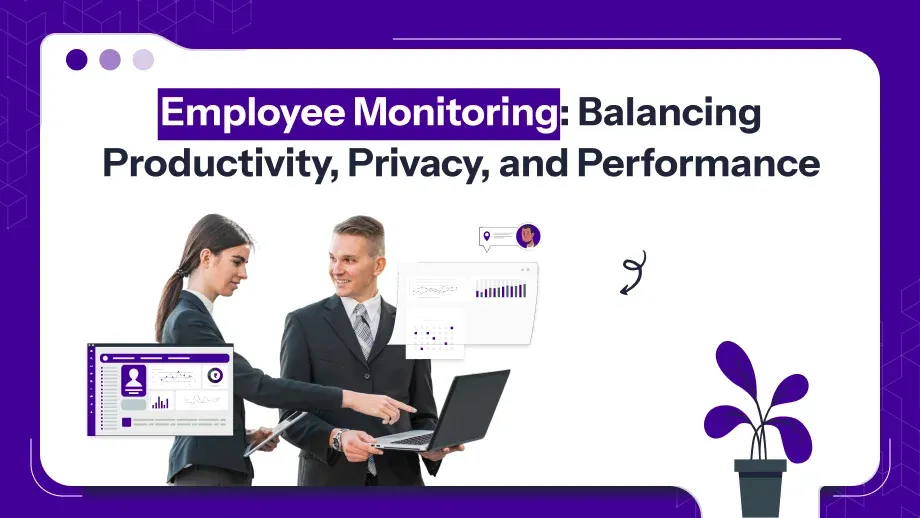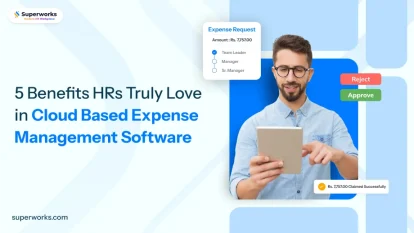
Introduction
Monitoring of employees is now the foundation of modern workplace management. Whether it’s monitoring attendance, making sure compliance is maintained, or increasing efficiency, tracking attendance, is essential to the way organizations operate today. What is monitoring by employees? And how can companies use it without compromising the privacy of employees? This blog focuses on the many aspects of employee monitoring such as its system, benefits issues, and top techniques.
What Is Employee Monitoring?
Employee monitoring is monitoring and monitoring employee activity in the workplace. It requires the use of instruments and systems that collect data on performance, tas,k, and efficiency.
The development of monitoring for employees began with paper timecards, but it has since evolved to more sophisticated digital systems powered by artificial intelligence. A comprehensive employee monitoring system of today has features such as time monitoring, productivity analysis as well as analytic tools for behavioral.
Examples:
- Logging work hours with cloud-based time and attendance systems
- Tracking location through GPS for field workers
- Monitoring software employee communication tools like emails
They help businesses ensure that their activities are aligned with the company’s targets while also ensuring that they are accountable.
Why Is Employee Monitoring Important?
Monitoring of employees is a key method that is the basis of modern-day organizational management. It plays an essential role in increasing productivity, making sure of conformity, protecting data, and improving overall operational effectiveness. The implementation of an effective work monitoring system serves several critical functions:
Boosting Productivity and Accountability
One of the major objectives of monitoring employees is to increase productivity. Through tracking hours of work task completion rates and levels of activity, these tools give real-time insight into worker performance. The employees are fully focused on their jo,b, particularly in situations that are prone to distractions, which can inhibit efficiency.
- The system encourages Time Management: Monitoring systems assist employees in staying on the right track in reducing time wasted.
- Increases accountability and trust employees tend to be more likely to adhere to deadlines and follow time frames when their work is monitored transparently.
Protecting Company Assets and Data Security
In the age of digital change, securing valuable company assets and sensitive data is essential. The systems of monitoring employees are an effective way to guard against possible breaches or misuse.
- Data leak prevention: Software for monitoring employees allows them to track access to files data downloads, communication, and access to avoid leaks of data.
- Device Monitoring: A lot of companies employ tools for monitoring company-owned devices to ensure they are properly used.
Conformity with Industry Regulations
Employee is vital in ensuring that employees are compliant with regulatory and legal guidelines for specific industries. Companies must frequently follow the laws on data protection, labor laws, as well as workplace safety laws.
- Audit Tracking Systems: These Systems keep detailed records of the activities performed by employees, which are useful for audits.
- Regulatory Adherence: For industries like finance and healthcare, where data handling is sensitive, monitoring ensures that employees follow protocols.
Facilitating Remote Work Management
The emergence of remote working has altered the way companies operate which has made monitoring of employees even more crucial than before. Remote employee monitoring tools allow companies to oversee teams distributed efficiently.
- Enhanced Visibility: Managers can track tasks and projects, even when employees work from different locations.
- Ensuring Accountability: Remote teams remain productive and meet deliverables on time with clear monitoring systems.
Looking for a solution to streamline employee monitoring?
Explore our top-rated tools that boost productivity while ensuring compliance.
Types of Employee Monitoring Tools
Time Tracking Software
Time tracking tools are among the most widely used employee monitoring systems, particularly for organizations focused on managing attendance and work hours. These tools allow employers to log employee activity in real-time, ensuring accurate work hour records.
- Key Features:
- Tracks employee login and logout times.
- Monitors break durations to identify unproductive hours.
- Offers weekly, daily, or monthly information regarding the attendance of employees.
- Benefits:
- It eliminates the requirement for hand-written timesheets.
- Supports payroll accuracy by syncing with HRMS payroll software.
- Helps employees productively manage their time.
- Time and attendance systems that are cloud-based and seamlessly integrated into HR software.
Productivity Monitoring Software
Tools for monitoring productivity track the ways employees work time, with a focus on the completion of tasks, app use, and web page activity. T hey are particularly useful for identifying workflow inefficiencies.
- Key Features:
- Tracks application and software usage to identify productive and non-productive activities.
- Monitors website visits to ensure alignment with work-related tasks.
- Generates reports detailing time spent on various tasks and projects.
- Benefits:
- Enhances task management by identifying bottlenecks.
- Provides managers with data to support performance reviews.
- Encourages employees to stay focused on priorities.
Communication Monitoring Tools
Tools for monitoring communications are utilized to monitor employee interactions through chats, emails, and phone calls. They are essential to ensure compliance, and that the channels of communication remain safe and professional.
- Key Features:
- Tracks emails for sensitive data or unauthorized sharing of information.
- Monitors internal chat platforms like Slack or Microsoft Teams.
- Provides keyword alerts for inappropriate or non-compliant language.
- Benefits:
- Helps protect intellectual property and sensitive data.
- Ensures adherence to workplace communication policies.
- Detects potential conflicts or miscommunication early.
GPS and Location Monitoring Tools
Location monitoring tools are indispensable for companies with field employees or those working remotely. These tools track employee locations during work hours to ensure task completion in designated areas.
- Key Features:
- Tracks employee locations in real-time via GPS.
- Verifies attendance at specific job sites.
- Allows geofencing to set location boundaries for employees.
- Benefits:
- Enhances accountability for field and remote workers.
- Ensures compliance with fieldwork schedules.
- Reduces fraudulent claims related to work locations.
- GPS tracking systems integrated with attendance monitoring system.
Pros of Employee Monitoring
Implementing monitoring software for employees offers significant advantages:
Increased Transparency and Trust
Clearly, communicated monitoring policies enhance trust between employees and employers.
Improved Resource Management
Organizations can allocate resources efficiently by understanding workload patterns.
Early Detection of Issues
Monitoring tools can help you identify possible issues or early employee detachment.
Data-Driven Decisions
Through detailed information, supervisors can make educated decisions about the promotion process, as well as training and the allocation of resources.
Cons of Employee Monitoring
Despite its benefits, employee software monitoring presents challenges:
Privacy Concerns
Monitoring too often can cause employees discontent or an impression of distrust.
Risk of Micromanagement
Over-monitoring can hamper autonomy and creativity.
Legal and Ethical Implications
Organizations must adhere to labor laws and ethical standards, ensuring monitoring remains fair and justified.
Impact on Morale
People may become demotivated if surveillance practices are intruding or if they are not properly communicated.
Legal and Ethical Considerations
Understanding Legal Requirements
Laws around employee vary across regions. For instance, organizations in Europe must comply with GDPR, ensuring employees’ data privacy.
Ethical Monitoring Practices
- Inform employees about monitoring practices
- Use monitoring tools only during work hours
- Avoid collecting personal data unrelated to work
Transparency and Consent
Establish a clear employee monitoring system policy and secure employee consent before implementation.
Best Practices for Implementing Employee Monitoring
Define Objectives
Clarify why monitoring is being implemented and what outcomes are expected.
Choose the Right Tools
Invest in a reliable monitoring software employee solution tailored to organizational needs.
Communicate Openly
Ensure employees understand how monitoring benefits them and the organization.
Provide Training
Train managers and employees to use monitoring tools effectively.
Review Regularly
Monitor systems and policies periodically to adapt to changing workplace dynamics.
Employee Monitoring in Remote Work
Remote work is now an everyday occurrence, businesses are faced with unique challenges to maintain the productivity of their employees. Tools like cloud HR system enable seamless tracking and management.
Benefits:
- Clear accountability for remote teams
- Enhanced visibility into work patterns
- Improved collaboration through tracking tools
Balancing flexibility and accountability is key when implementing remote monitoring systems.
The Future of Employee Monitoring
Employee is evolving rapidly with advancements in technology. Here are some of the latest trends:
AI-Driven Insights
Future systems will offer predictive analytics for proactive performance management.
Integration with HRMS and Payroll Systems
Monitoring tools are increasingly integrated with HRMS payroll software in India, offering holistic employee management.
Employee-Centric Monitoring
Moving from monitoring to empowerment, new technologies are designed to improve customer experiences.
Conclusion
When implemented thoughtfully, is an effective method to increase the efficiency of your employees, as well as security and security. But, companies must find the right balance between reaching the goals of their operations while respecting employees’ privacy. Through implementing transparent procedures using the most advanced technology, as well as maintaining open communications organizations can establish an atmosphere that promotes respect and performance as well as confidence.
Whether you’re exploring a top HR software solution or integrating monitoring features into your existing systems, remember that employee should always align with organizational values and employee well-being.






